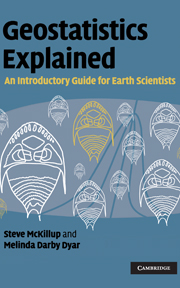Book contents
- Frontmatter
- Contents
- Preface
- 1 Introduction
- 2 “Doing science”: hypotheses, experiments and disproof
- 3 Collecting and displaying data
- 4 Introductory concepts of experimental design
- 5 Doing science responsibly and ethically
- 6 Probability helps you make a decision about your results
- 7 Working from samples: data, populations and statistics
- 8 Normal distributions: tests for comparing the means of one and two samples
- 9 Type 1 and Type 2 error, power and sample size
- 10 Single-factor analysis of variance
- 11 Multiple comparisons after ANOVA
- 12 Two-factor analysis of variance
- 13 Important assumptions of analysis of variance, transformations and a test for equality of variances
- 14 Two-factor analysis of variance without replication, and nested analysis of variance
- 15 Relationships between variables: linear correlation and linear regression
- 16 Linear regression
- 17 Non-parametric statistics
- 18 Non-parametric tests for nominal scale data
- 19 Non-parametric tests for ratio, interval or ordinal scale data
- 20 Introductory concepts of multivariate analysis
- 21 Introductory concepts of sequence analysis
- 22 Introductory concepts of spatial analysis
- 23 Choosing a test
- Appendices
- References
- Index
22 - Introductory concepts of spatial analysis
Published online by Cambridge University Press: 05 June 2012
- Frontmatter
- Contents
- Preface
- 1 Introduction
- 2 “Doing science”: hypotheses, experiments and disproof
- 3 Collecting and displaying data
- 4 Introductory concepts of experimental design
- 5 Doing science responsibly and ethically
- 6 Probability helps you make a decision about your results
- 7 Working from samples: data, populations and statistics
- 8 Normal distributions: tests for comparing the means of one and two samples
- 9 Type 1 and Type 2 error, power and sample size
- 10 Single-factor analysis of variance
- 11 Multiple comparisons after ANOVA
- 12 Two-factor analysis of variance
- 13 Important assumptions of analysis of variance, transformations and a test for equality of variances
- 14 Two-factor analysis of variance without replication, and nested analysis of variance
- 15 Relationships between variables: linear correlation and linear regression
- 16 Linear regression
- 17 Non-parametric statistics
- 18 Non-parametric tests for nominal scale data
- 19 Non-parametric tests for ratio, interval or ordinal scale data
- 20 Introductory concepts of multivariate analysis
- 21 Introductory concepts of sequence analysis
- 22 Introductory concepts of spatial analysis
- 23 Choosing a test
- Appendices
- References
- Index
Summary
Introduction
Earth scientists often rely on different types of maps where the spatial location of each sampling unit is one of the variables of interest. For example, a geoscientist might have data for the presence or absence of copper-bearing ore at 54 test cores drilled within the sampling space of a 10 000 square mile mining lease. The effectiveness of any further prospecting would be improved if you knew whether the spatial distribution of cores showing copper-bearing ores occurred at random or in some sort of pattern within the sampling space. The methods for summarizing and analyzing such data are called spatial analyses.
Even though the Earth is three-dimensional, most summary spatial information is presented as two-dimensional maps representing the Earth's surface, often with an overlay to indicate other variables. For example, maps showing landforms are printed on two-dimensional sheets, with contour lines and numbers to show the third dimension of elevation. Similarly, a map of the location and flow per minute of test wells for oil might indicate flow with numbers (e.g. the average number of barrels per day from each well) or display this as the proportional height of a single bar at each well.
The location of any point on a two-dimensional surface can be accurately and precisely defined by its X and Y coordinates, which are the distances in two directions at 90° to each other from a set reference point, in just the same way as a graph is used to display a two-dimensional scatter plot of bivariate data.
- Type
- Chapter
- Information
- Geostatistics ExplainedAn Introductory Guide for Earth Scientists, pp. 334 - 363Publisher: Cambridge University PressPrint publication year: 2010



